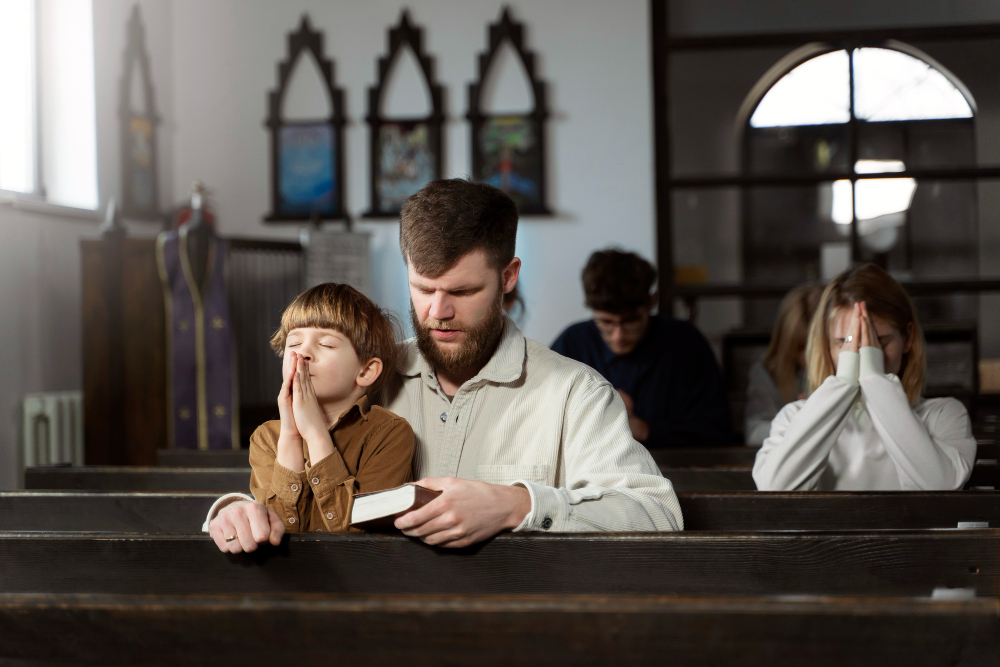What can parents do on a daily basis to help predispose their children properly to receive the Eucharist?
Along with Baptism and Confirmation, First Communion is one of the three sacraments of Christian initiation. Most often, children in the Latin Rite receive the Eucharist for the first time when they reach the age of reason, between the ages of 7 and 13 (local traditions vary).
According to the Code of Canon Law, children must have “sufficient knowledge” and have received “careful preparation so that they understand the mystery of Christ according to their capacity and are able to receive the body of Christ with faith and devotion” (Canon 913). The future communicant follows a specific preparation over several months, at the parish or at school, which may end with a small retreat.
Nevertheless, parents also have a role to play in the preparation. “It is primarily the duty of parents and those who take the place of parents, as well as the duty of pastors, to take care that children who have reached the use of reason are prepared properly and, after they have made sacramental confession, are refreshed with this divine food as soon as possible,” the code continues (Canon 914). What can we do on a day-to-day basis to help predispose our children properly?
The first thing to do is to follow up on preparation given at the school or parish. We can ask our children: “What did you talk about during the class? What did you learn? What impressed you most?” Our interest shows that we aren’t taking the lead-up to this sacrament lightly and that we value the sacrament of the Eucharist.
Secondly, our way of being, especially during the Mass, permeates and marks our children. Thus, letting our own desire to receive Communion shine through is a way of preparing them to receive the sacrament of the Eucharist.
Finally, during the whole period of preparation, it’s good to pay special attention to our children during Mass. We can make sure to arrive on time so that our children can see the altar well and thus remain more attentive. Following the celebration with the help of a missal will help them (and us) concentrate and understand the Mass and the texts. But the best school for understanding the liturgy is to serve Mass!
Special attention to the Eucharistic liturgy
If there’s a time during the Mass when we should invite our children to be particularly attentive, it’s during the liturgy of the Eucharist. We can encourage them to listen carefully to the priest, to watch him, to observe the gestures of his hands: lifted and open towards Heaven, turned towards the congregation or towards the altar, or holding the host. The teachings they have received during catechism will then be able to resonate in them. We can also whisper a few explanations: “It’s Jesus Himself who offers himself to us in the bread and wine,” “Jesus is going to come to each one of us …”
During the offertory, we can invite them to place their good and bad deeds and their joys and sorrows in the hands of the Lord. At the moment of the elevation, why not encourage them to simply say, “Thank you Lord, I love you.” This is a way of teaching them to be particularly close to Jesus at the moment when He becomes present in the midst of the assembly.
After receiving communion, the faithful are invited to pray. Even if our children haven’t yet received the host, we can offer to pray with them.
A simple “thank you,” said with faith and love, is an excellent prayer for giving thanks after communion. “The wise men would’ve been quite happy to leave the manger and take the baby Jesus home with them,” said the holy Curé d’Ars. We can make our children aware of the gift we receive when we receive Communion. As St. Julien Eymard says, “Thanksgiving after communion does not require an elevated spiritual life.”
Finally, as the day of their First Communion approaches, we can ask them to choose small holy cards to hand out to our loved ones as a souvenir of the occasion. They can write their first name and the date on them, and be inspired by the sweetness or the symbolism of the images.
Source: aleteia.org
